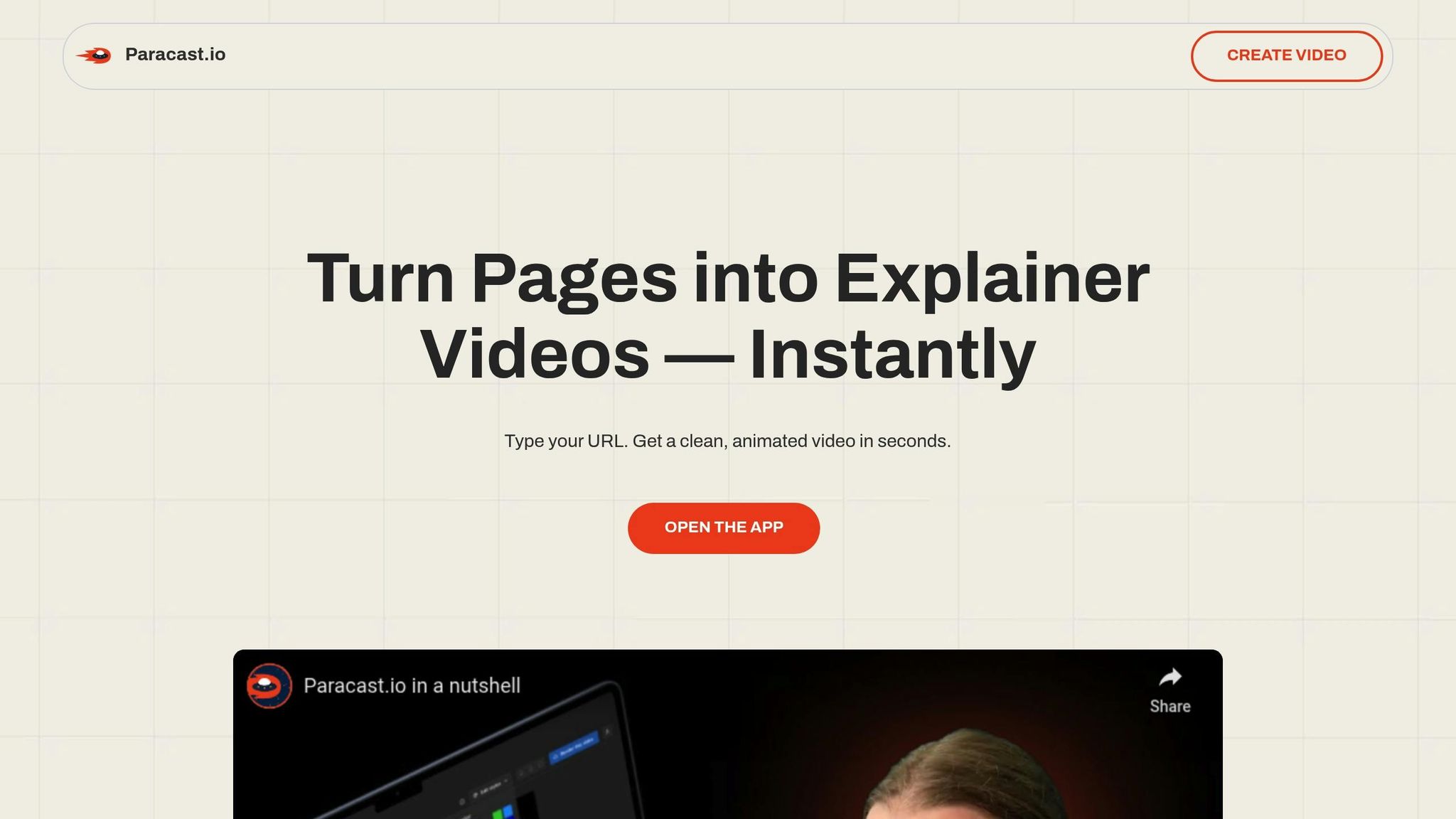Collaborating with influencers to create videos is one of the most effective ways to connect with your audience, build trust, and drive results. With influencer marketing projected to reach $32.55 billion by the end of 2025, brands are earning an average of $5.78 for every dollar spent. Here’s a quick breakdown of how you can co-create impactful videos with influencers:
- Find the Right Influencer: Match your brand with influencers whose values, audience, and content style align with yours. Use tools like Instagram Insights or TikTok Pro to analyze engagement and audience demographics.
- Set Clear Goals: Define specific, measurable objectives for the campaign - like increasing brand awareness or driving sales - and choose relevant metrics to track.
- Plan the Video: Collaborate with influencers to brainstorm ideas that balance your brand’s message with their creative style. Structure the video into a strong hook, value-driven content, and a clear call-to-action.
- Produce the Content: Focus on high-quality filming, clear audio, and smooth visuals. Use AI tools like Paracast.io to streamline editing and customize videos for each social platform.
- Track Results and Improve: Measure performance using metrics like engagement, reach, and conversions. Combine data insights with influencer feedback to refine future campaigns.
These steps help ensure your videos resonate with viewers, turning them into loyal customers while maximizing ROI.
Step 1: Find the Best Influencer Match
Know Your Target Audience
To find the right influencer, start by identifying the key demographics of your ideal customers - think about age, location, and interests. Studies reveal that 80% of marketers consider influencer marketing a powerful way to connect with target audiences and achieve their objectives. Tools like Instagram Insights, YouTube Analytics, and TikTok Pro can provide detailed data on audience demographics and engagement trends. Once you've got that information, make sure the influencer's values align with your brand's mission.
Check Brand-Influencer Fit
For a partnership to feel genuine, there needs to be a strong alignment between your brand and the influencer. Research shows that 67% of consumers appreciate collaborations that are honest and unbiased.
"Brands should prioritize influencers whose values align with their mission"
- Marlie Love, Content Creator and Co-Founder, Traveling While Black
When evaluating potential partners, consider engagement benchmarks across platforms:
| Platform | Nano Influencers | Micro Influencers | Macro Influencers |
|---|---|---|---|
| 5% | 3.5% | 2% | |
| TikTok | 18% | 12% | 8% |
| YouTube | 3.5% | 3% | 2% |
These numbers can help you identify influencers who seamlessly fit your brand's aesthetic. For instance, Antique Candle Co. saw success with Liz Marie due to their natural alignment. Similarly, Yakult partnered with Ricky's Time, a certified nutritionist, to effectively connect with health-conscious audiences.
Research Influencer Stats
Go beyond follower counts and focus on metrics that matter. TikTok, for example, boasts engagement rates of 10–15%, while Instagram ranges between 1% and 4%.
"Don't just look at the influencer's reach; align with those who mirror your brand's soul."
- Holger Sindbaek, Founder of Online Solitaire
When assessing potential influencers, keep an eye on:
- Consistent engagement rates
- Authentic follower growth
- Quality of comments and interactions
- Performance in previous brand collaborations
- Content style and production quality
A great example of effective influencer matching is Flannels' #PartyNeverStops campaign, which generated $4.6 million in sales and reached 11.9 million unique users.
Influencer Marketing Strategies: 9 Ways to Collaborate with Influencers
Step 2: Set Project Goals
Once you've chosen your influencer, the next step is to establish clear objectives that will steer your collaboration in the right direction.
Write SMART Goals
To make your influencer partnership effective, focus on creating SMART goals - those that are specific, measurable, achievable, relevant, and time-bound. Why? Because marketers who set well-defined goals are four times more likely to achieve success with their campaigns.
When drafting SMART goals, aim for outcomes you can quantify. For instance, if your goal is to boost brand awareness, you might write: "Generate 100+ Instagram Reels from micro-influencers (2,000–50,000 followers) for our new product launch during Q1 2025, with plans to repurpose the content in Q2".
Key elements to include in your goals:
- Clearly defined metrics
- Realistic deadlines
- Alignment with your business objectives
- Measurable results
- Success criteria that are easy to track
Once your goals are in place, the next step is to identify the right metrics to measure progress.
Pick Key Metrics
To assess the success of your campaign, choose metrics that directly tie back to your goals. According to research, 68% of marketers track social media engagement, while 50% focus on traffic generated from social posts.
Here’s a framework to help you select key performance indicators:
| Goal Type | Primary Metrics | Secondary Metrics |
|---|---|---|
| Brand Awareness | Video views, Reach | Brand mentions, Hashtag usage |
| Engagement | Comments, Shares | Average watch time, Save rate |
| Conversion | Sales, Sign-ups | Click-through rate, Cost per acquisition |
By focusing on the right metrics, you can better evaluate the impact of your influencer collaboration.
Create Legal Documents
A solid contract is essential to protect both you and the influencer while ensuring the partnership runs smoothly. Did you know that influencer marketing is 10.52 times more cost-effective than paid media? That makes setting clear terms even more critical.
Your contract should cover:
- Ownership and usage rights for content
- FTC disclosure requirements
- Payment details, including terms and schedules
- Performance expectations
- Content guidelines
- Posting timelines
- Exclusivity clauses
Keep in mind that failing to meet FTC guidelines can lead to fines exceeding $50,000 per violation. To avoid this, make sure your agreement includes explicit instructions for sponsored content disclosure and adheres to platform-specific rules.
Step 3: Design the Video
Share Ideas Together
After finding the right influencer-brand match, the next step is to align your creative visions. Open communication between the brand and influencer is key to creating content that feels genuine and connects with both audiences. Research shows that successful partnerships focus on producing content that feels authentic and relatable to viewers.
When brainstorming video ideas, keep these points in mind:
- Brand alignment: Share your core values, messaging, and insights about your target audience.
- Creative freedom: Let influencers bring their unique style and personality into the content.
- Audience engagement: Choose formats that resonate best with the influencer's followers.
- Technical details: Discuss specific requirements like video length, format, and platform preferences.
A great example of this is the collaboration between Prime Drink and IShowSpeed. By allowing the streamer to showcase the product in his signature energetic style, they created highly engaging and memorable content.
Once ideas are aligned, focus on structuring the video for maximum impact.
Map Out Video Flow
A well-structured video keeps viewers hooked and ensures your message lands effectively. Break your video into three clear sections:
- Hook (first 5-7 seconds): Start strong with an opening that grabs attention and addresses a key audience need or curiosity.
- Value delivery (middle): This is where you present your main message, supported by visuals, demonstrations, or storytelling.
- Call-to-action (closing): Wrap up with a direct and actionable next step for viewers.
| Video Section | Duration | Key Elements |
|---|---|---|
| Opening Hook | 5-7 seconds | State the problem; spark curiosity |
| Main Content | 60-90 seconds | Deliver key messages, use visuals/B-roll |
| Closing CTA | 10-15 seconds | Add a clear action step; reinforce branding |
Use Paracast.io Tools

To streamline the video design process, take advantage of Paracast.io's AI-powered tools. These tools are specifically designed to help brands and influencers create polished, professional videos while maintaining creative flexibility.
Here’s how Paracast.io can help:
- Ready-made templates: Choose from layouts optimized for social media platforms.
- Customization options: Adjust colors, fonts, and animations to match both the brand and influencer's style.
- High-quality output: Produce videos in 1080p resolution for use across major platforms.
- Quick iterations: Experiment with multiple concepts and refine them quickly before finalizing.
These tools make it easier to balance creativity with consistency, ensuring your video stands out while staying true to your brand.
sbb-itb-5bfa442
Step 4: Make the Video
Film and Collect Content
Creating a great video starts with nailing the basics of filming. When collaborating with influencers, focus on these essentials to ensure your content grabs attention:
- Lighting matters: Natural light is ideal, but consistency is key. If you're shooting outdoors, plan around the weather to avoid uneven lighting.
- Clear audio is a must: Choose quiet locations and use external microphones for sharp sound quality. For voiceovers, have scripts ready and record using reliable apps for clean audio.
- Keep it steady: Shaky footage can ruin even the best ideas. Use tripods or stabilizers for smooth visuals.
- Add movement: Start with dynamic shots to hook viewers right from the beginning.
"Social video should be short. Social video should encapsulate very quick, concise points, and should point to something else." – Stacy Adams, Head of Marketing at GoAnimate
Once you've captured your raw footage, the next step is refining it through editing.
Edit with AI Support
With your footage ready, it's time to polish it. AI-powered editing tools make this process faster and more efficient while still giving you creative control. For instance, Paracast.io offers features like:
- Automatic color adjustments for a consistent look
- Cutting out awkward pauses to tighten pacing
- Generating accurate captions for accessibility
- Adding transitions and effects that align with your brand
The growing demand for AI in video editing is evident, with the market expected to hit $1.32 billion by 2032. These tools are becoming a game-changer for content creators.
Format for Each Platform
After editing, customize your video to fit the specific requirements of each social platform. Different platforms have their own "rules" for video formats to maximize reach and engagement:
| Platform | Optimal Format | Key Considerations |
|---|---|---|
| Square (1:1), Portrait (4:5), Stories (9:16) | Add captions in the top left quadrant | |
| Landscape (16:9) | Videos are 20x more likely to be shared | |
| Square (1:1), Landscape (16:9) | Optimize for sound-off viewing | |
| TikTok | Vertical (9:16) | Leverage native platform features |
To make your videos stand out:
- Think mobile-first: Make sure text and visuals are easy to see on small screens.
- Use captions: Many viewers watch without sound, so captions ensure your message gets across.
- Design custom thumbnails: A strong thumbnail can boost click-through rates significantly.
Tailoring your video to each platform ensures it performs well and connects with your audience wherever they are.
Step 5: Track and Improve Results
Check Performance Data
When it comes to measuring success, focus on these key metrics:
| Metric Type | What to Track | Target Range |
|---|---|---|
| Engagement | Likes, comments, shares | 1–3% rate (up to 5% for micro-influencers) |
| Reach | Unique viewers, impressions | Platform-specific benchmarks |
| Conversion | Click-through rate, sales | $5–$6.50 ROI per $1 spent |
| Brand Impact | Mentions, hashtag usage | Varies by campaign |
Here’s how to dive deeper into your data:
- Use unique tracking links and promo codes to pinpoint conversions.
- Keep an eye on website traffic spikes and cross-platform engagement.
- Calculate ROI by comparing revenue generated to campaign costs.
"Measuring the success of a marketing campaign is pivotal to success, and identifying the right metrics that can provide that information will help you make data-informed strategy decisions."
Once you’ve analyzed the numbers, it’s time to hear directly from the influencers.
Get Influencer Input
Influencers are on the front lines of your campaign, so their feedback is crucial. Here’s how to gather it effectively:
- Schedule brief video check-ins during the campaign to discuss progress.
- Use quick polls to get insights on specific content elements.
- Monitor social listening reports to gauge audience reactions.
- Document what works well with their audience to inform future campaigns.
"I like to see two rounds. Round one, you give feedback. Round two is 99% ready to go, or there's like one small tweak that needs to be made. Including that in the contract is super important." - Delaney Henson, Influencer Marketing Leader at Tonal
By combining performance data with influencer feedback, you’ll be better equipped to refine your strategy.
Plan Next Steps
To make your next campaign even stronger:
- Compare your results to industry benchmarks to see how you stack up.
- Identify the video styles that generated the most engagement.
- Adjust content length and format based on platform-specific performance trends.
- Double down on approaches that worked well with proven influencers.
It’s worth noting that 88% of marketers who track video performance report being satisfied with their ROI.
Conclusion
Collaborating with influencers to create videos can lead to genuine engagement and measurable outcomes. This approach reshapes brand outreach by combining meaningful partnerships with data-focused strategies.
"I think it's really easy to go out and collaborate with a ton of influencers that drive incredibly high conversions. But they're not necessarily on brand, and they may not even be creating content that you wanna reuse. So there is a sweet spot when you can find people that align with your brand and are creating content that you could reuse and drive conversions."
Real-world examples highlight the power of this strategy. Colgate’s #MakeMomSmile campaign amassed over 5 billion TikTok views, and ba&sh’s collaboration with Arielle Charnas of Something Navy reached 1.2 million Instagram followers.
To simplify the video production process, tools like Paracast.io offer AI-powered templates and customization options. These features save time while ensuring professional-quality videos for influencer partnerships.
Here’s what drives lasting success with influencer campaigns:
- Focus on authentic connections that match your brand's values and speak to your audience.
- Encourage creative freedom, but set clear boundaries and expectations.
- Track performance metrics to refine and improve future campaigns.
- Build long-term relationships with influencers who can evolve into brand ambassadors.
"Be genuine, stay true to your brand and tell the brand story. Only work with influencers who are aligned with the brand vision and mission and purpose." - Laricea, Achillea Beauty
FAQs
How can I make sure an influencer’s video content matches my brand’s message?
To make sure an influencer’s video content matches your brand’s message, start by providing a clear and detailed creative brief. Lay out your brand’s tone, values, key messages, and any specific dos and don’ts for the video. The more specific you are, the easier it is for the influencer to create content that connects with your audience.
Also, prioritize open communication throughout the process. Work closely with the influencer during the planning and review stages to agree on the content’s direction. While doing this, give them room for creative expression. This way, the final video will stay true to their unique style while still representing your brand effectively.
What are the best ways to measure the success of a video campaign with influencers?
To evaluate how well a video campaign with influencers is performing, you’ll want to keep an eye on several key metrics:
- Reach and impressions: Check how many people saw the video and how often it showed up in their feeds.
- Engagement rates: Look at likes, shares, comments, and other interactions to see how much the audience is engaging with the content.
- Follower growth: Notice if your social media following grows during or after the campaign.
- Click-through rates (CTR) and conversions: Track how many viewers clicked on your links or took actions like visiting your site or making a purchase.
- Return on investment (ROI): Compare the campaign’s financial results to what you spent to determine its profitability.
By diving into these metrics, you’ll get a clear picture of how well your campaign connected with your audience and supported your marketing objectives.
How can AI tools like Paracast.io make video editing easier when working with influencers?
AI tools like Paracast.io make video editing easier by handling tasks like scene detection, color correction, and audio tweaking automatically. This not only cuts down on the time spent editing but also frees creators to focus more on crafting compelling stories and bringing their creative ideas to life.
On top of that, Paracast.io enables real-time collaboration, which is a game-changer for influencers and brands working together on video projects. The platform also uses AI to analyze how audiences engage with your content, helping you adjust and optimize your videos to better connect with your target viewers.


